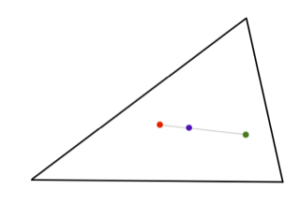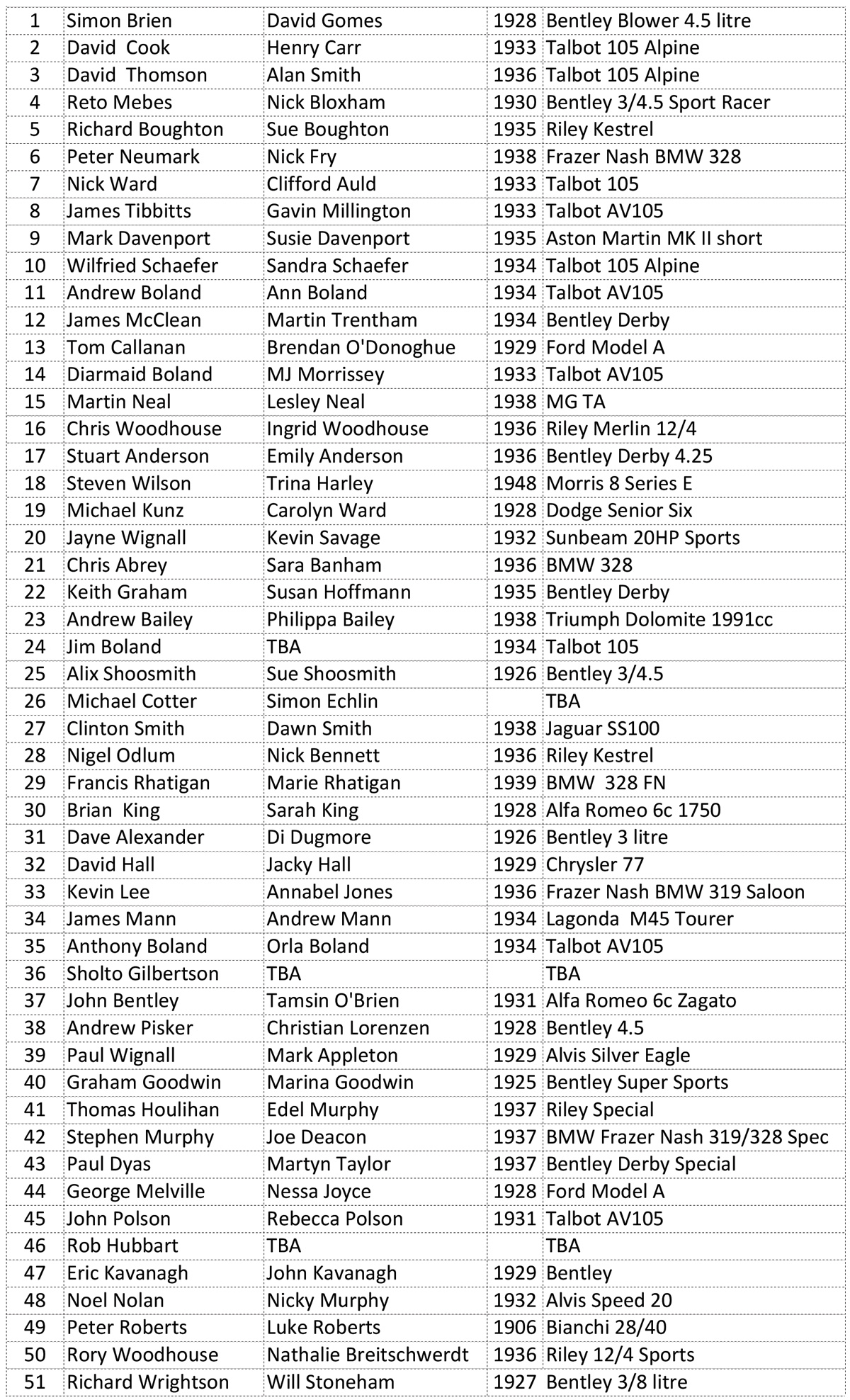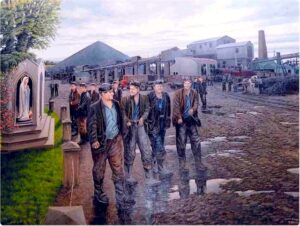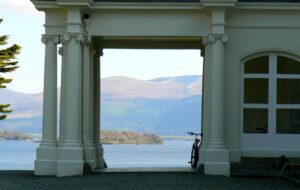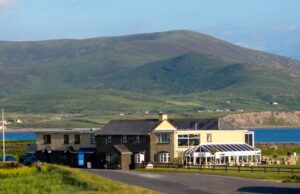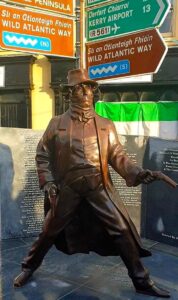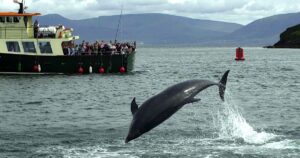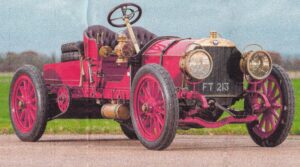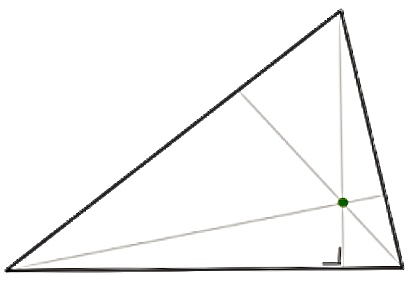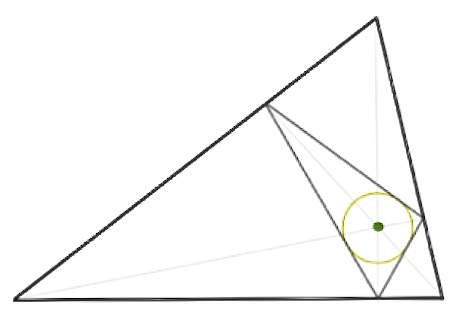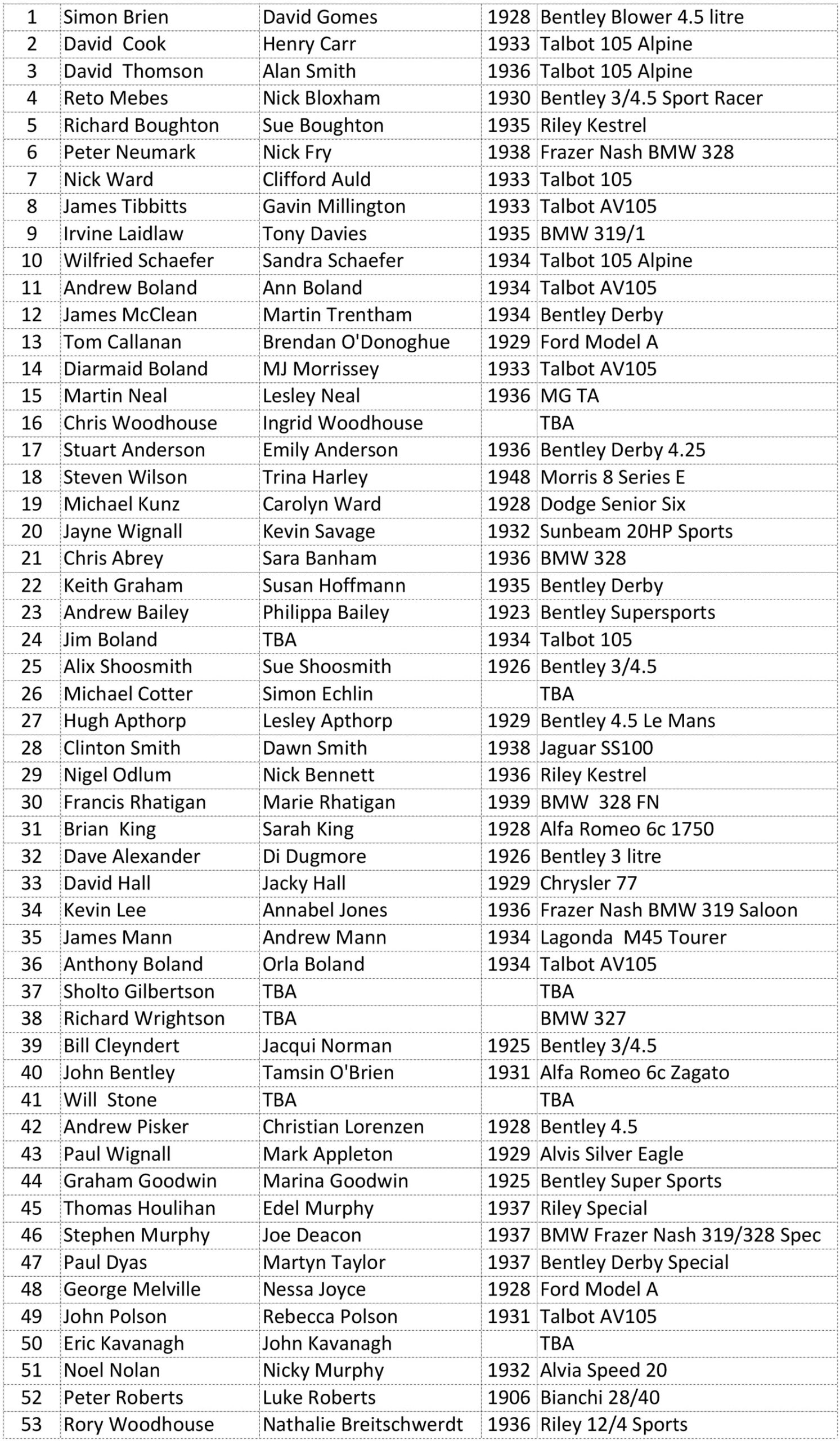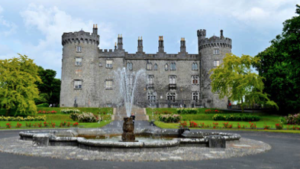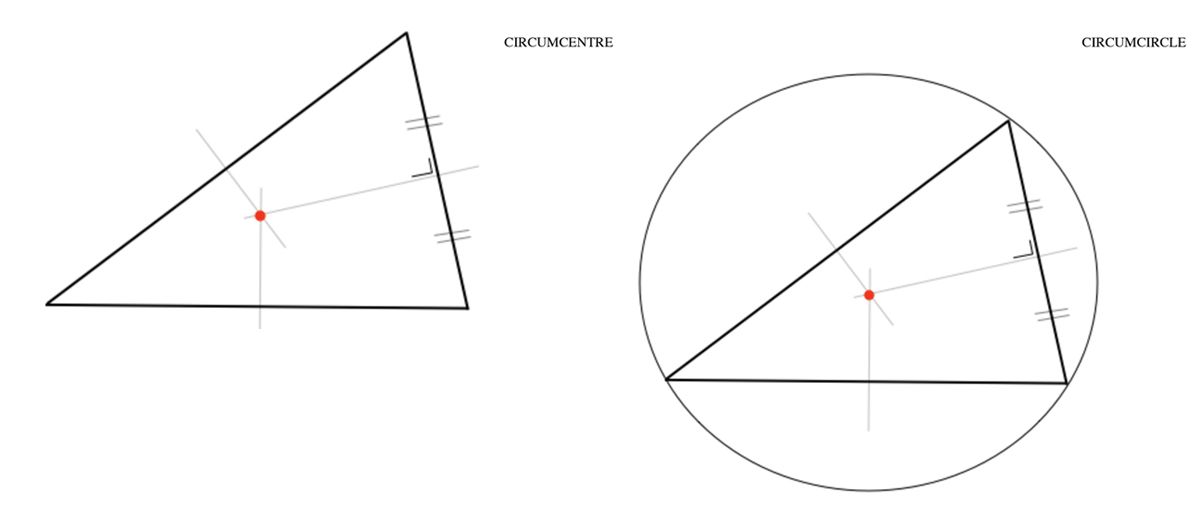It’s looking like there will be some serious competition for honours in this year’s Shamrock. A perusal of the recent Flying Scotsman results reveals quite a few competitors who will be taking part in this year’s fray. Significantly, there is a high proportion of the “Top Ten” coming our way. Crews, Andrew & Philippa Bailey were sixth and Stuart & Emily Anderson were eighth. Drivers Paul Dyas and Peter Neumark were fourth and seventh – no pressure on Martyn Taylor and Nick Fry then! Also worthy of mention are David Thomson and Trina Harley who made impressions behind the wheel and on the maps, respectively and separately. Incidentally, it was good to see that inaugural Shamrock Vintage Challenge winner, John Abel is back in action again – he hasn’t lost his touch either.

Peugeot Partner
One of our tasks was to mark the time points so as to facilitate their location by the marshals. Shy, retiring Mickey chose for this exercise a discreet fluorescent pink aerosol spray. While this has the advantage of being clearly visible to the officials, it can be misinterpreted. Indeed, one of “our” landowners brought the one outside his gate to the attention of the “Gardaí” fearing that his house had been marked as being worthy of the nefarious consideration of local “ne’er-do-wells”.
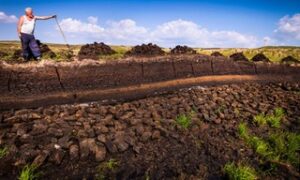
Peat Bog
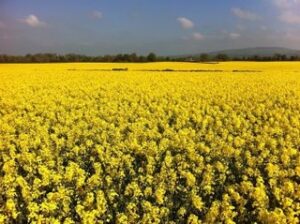
Spring oilseed rape
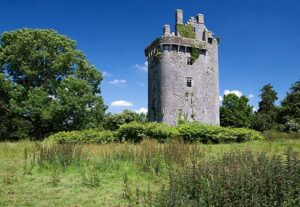 Another of Mickey’s interests is old buildings. The more castellar the better, though he eulogises about what looked to me like pretty run-down and derelict dwellings from the past almost as much as he does the more spectacular edifices. One of our hosts, John Cott, lives very close to the magnificent (Mickey’s opinion) Lohort Castle. It is one of those hidden gems which remain largely inaccessible to the general public. It is situated on the Castlelohort Demesne near Cecilstown in County Cork. and is an impressive five storey fortified tower with rounded corners, standing over 80 feet tall. The massive walls are 10 feet thick at the base, narrowing to six feet. Around the top storey there is a machicolated parapet that runs unbroken apart from a short section on the eastern side. There used to be a deep moat around the castle with a drawbridge. The castle grounds cover more than 100 acres. It was built around 1496 by Donogh Óg McDonagh McCarthy. The castle was taken by the Irish forces during the Civil War. One of the bloodiest battles of the English Civil War took place on the grounds of Lohort Castle in in 1647 when over 4,500 men were killed in battle. Lohort was bombarded by Oliver Cromwell’s troops in 1650 and captured, but the castle withstood the cannon fire due to the immense strength of its 10 foot thick walls. The castle as it now stands was rebuilt around 1750 by Sir John Percival, the Earl of Egmont, and the Percivals lived there until the 20th century when it was burned down by the IRA in 1922. Some of the fireplaces from nearby Kanturk Castle appear to have been relocated to Lohort Castle – this was probably done when Lohort Castle was restored in the 18th century.
Another of Mickey’s interests is old buildings. The more castellar the better, though he eulogises about what looked to me like pretty run-down and derelict dwellings from the past almost as much as he does the more spectacular edifices. One of our hosts, John Cott, lives very close to the magnificent (Mickey’s opinion) Lohort Castle. It is one of those hidden gems which remain largely inaccessible to the general public. It is situated on the Castlelohort Demesne near Cecilstown in County Cork. and is an impressive five storey fortified tower with rounded corners, standing over 80 feet tall. The massive walls are 10 feet thick at the base, narrowing to six feet. Around the top storey there is a machicolated parapet that runs unbroken apart from a short section on the eastern side. There used to be a deep moat around the castle with a drawbridge. The castle grounds cover more than 100 acres. It was built around 1496 by Donogh Óg McDonagh McCarthy. The castle was taken by the Irish forces during the Civil War. One of the bloodiest battles of the English Civil War took place on the grounds of Lohort Castle in in 1647 when over 4,500 men were killed in battle. Lohort was bombarded by Oliver Cromwell’s troops in 1650 and captured, but the castle withstood the cannon fire due to the immense strength of its 10 foot thick walls. The castle as it now stands was rebuilt around 1750 by Sir John Percival, the Earl of Egmont, and the Percivals lived there until the 20th century when it was burned down by the IRA in 1922. Some of the fireplaces from nearby Kanturk Castle appear to have been relocated to Lohort Castle – this was probably done when Lohort Castle was restored in the 18th century.
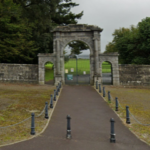
Doneraile Castle
As you approach the final test of the event you will be directed around the back of the imposing Churchtown House where you will stumble upon the skeleton of an unfinished 120-bed hotel. What a fantastic location – surely the developers amongst you will be eager to snap up a bargain!!!
The extracts below from a piece in the Irish Examiner in December 2014 will provide you with some background.
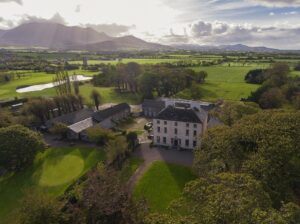
Churchtown House
We are fortunate to have “our man in Waterville” in the person of Simon Harrison who has been responsible for “oiling the wheels” of our visit to the town. Below is an abridged version of one of his recent missives.
Shamrock 2022 – Update Report 2nd April 2022 DAY 3 – Iveragh – Ballaghisheen Pass, Waterville, Ballinaskelligs, Kells, Glencar. Mobile Coffee just below Ballaghisheen Pass.Wholly Dough – Julie Lee King – confirmed and price agreed. Deposit requested and SH meeting on 23rd April to recce location. Old Post Office/ChurchOwners John O’Brien (Father); Darren O’Brien (Son) visited on 5th March. Happy for route to pass through section of their yard. Need a reminder phone call beforehand. Met owner of White Cottage – wild bachelor farmer with long flyaway hair and pretty deaf and unintelligible. Had communication rather than chat but he is quite happy for cars to pass him. The track now has had some attention and a good surface. Since last report, the Waterville Meander route checked by the Michaels is viable. Bayview Test – now confirmed – entry via tunnel and exit beside Sea Lodge. May need to keep some space for the parking of the last 15 or so cars. Permission has been given to park cars on the grass in front of the Bayview. Note on Parking – the grass area opposite Sealodge is not suitable, however as per above permission now to hand to park on the grass immediately in front of the Bayview which should be good for about 15 cars. Sealodge will keep their front area free for parking which should take 24 cars max with double parking to both sides. Balance of parking therefore suggested for section closest to Sealodge behind Bayview. Parking in front of Sealodge circa 24 cars if managed. Co-Op Test (on road to Ballinaskelligs) needs to coincide with their lunch hour 1-2pm – all confirmed, requesting copy of insurance, which can be emailed to me. Afternoon Coffee Stop and Test TC 3/3 at Golden’s Kells is “ready to roll”. Refeshments will be Barrista Coffee (full menu) and Homebake – test on Glenbeigh side of carpark. Pub Stop at Climbers Inn for a pint has been agreed – expect they will call me to reconfirm. DAY 3 – Dingle. Lunch Stop in Dingle Skellig Hotel and test and parking adjacent overflow carpark across road confirmed. Soup and deluxe sandwiches.
Just a brief word about units. As you will be aware, courtesy of the Regs, the distances in the route instructions are given in miles. Not mentioned are the units of time which you would assume (correctly) are hrs.mins.secs. However, I had occasion to make a phone call to Newry recently and encountered a unit of time peculiar to the “North”: the “wee minute” – as in “Would you hold on for a wee minute please?”. Given that there are quite a few competitors from that jurisdiction, I felt it worth mentioning this potential pitfall so as to avoid any possible confusion. Neither, of course, will the less common “wee second” be used.
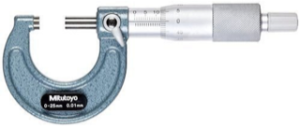
You will be relieved that my mathematical meanderings have almost come to an end. I will finish in this edition with a couple of vaguely connected whimpers. Is a µm a micron or one of these? (left)
√-4 = 2
It’s all fun and games
until someone loses an i
– Norbury
 P.S. A task, additional to an official’s timekeeping/observing primary function, is quite often chatting to the locals. The big advantage of the cars being “pre-war and the sensible regularity speeds (on the public road at least!) results in these being congenial affairs. However, occasionally, there can be some disquiet when drivers become a little bit over-enthusiastic when departing from time points so as to recover the time lost at the point. Please proceed in a fashion sufficiently demure to avoid umbrage. The TP locations have been chosen carefully so as to preclude the necessity to indulge in unseemly behaviour.
P.S. A task, additional to an official’s timekeeping/observing primary function, is quite often chatting to the locals. The big advantage of the cars being “pre-war and the sensible regularity speeds (on the public road at least!) results in these being congenial affairs. However, occasionally, there can be some disquiet when drivers become a little bit over-enthusiastic when departing from time points so as to recover the time lost at the point. Please proceed in a fashion sufficiently demure to avoid umbrage. The TP locations have been chosen carefully so as to preclude the necessity to indulge in unseemly behaviour.
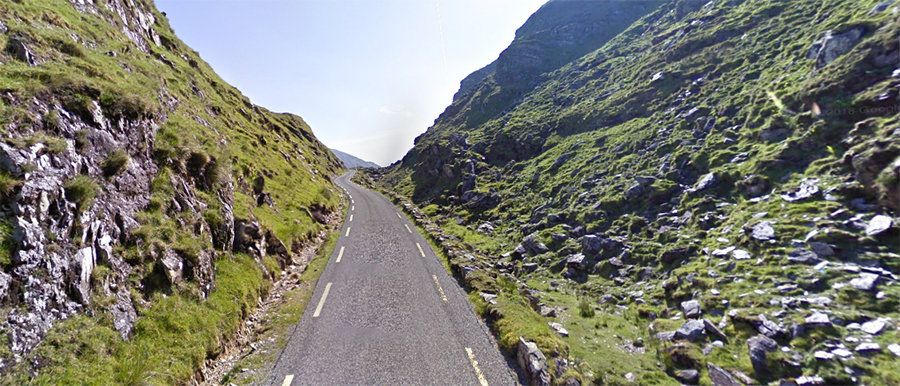
You will be very impressed when you pass through the Ballaghbeama Gap
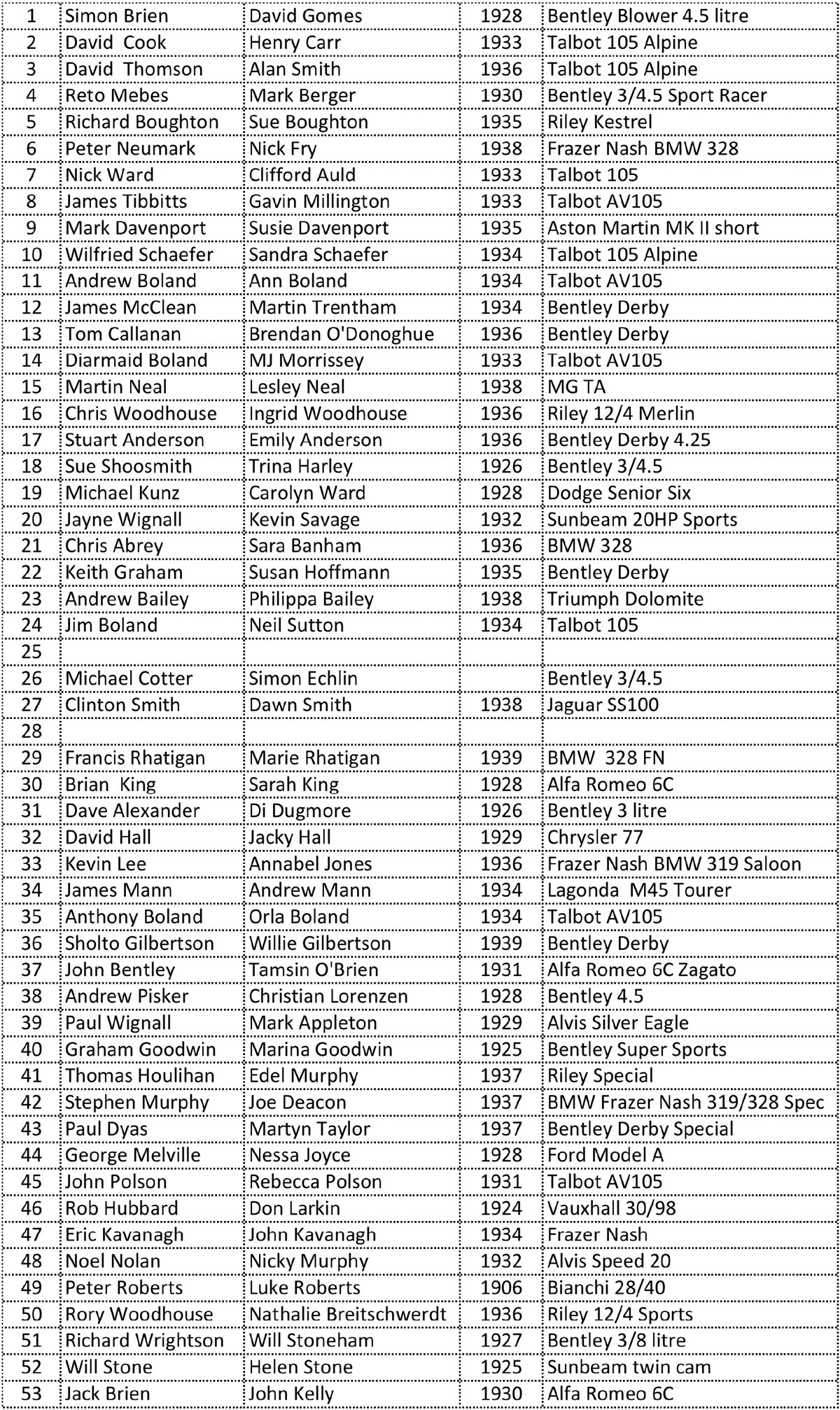

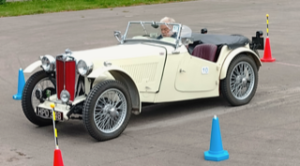
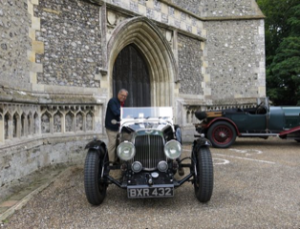
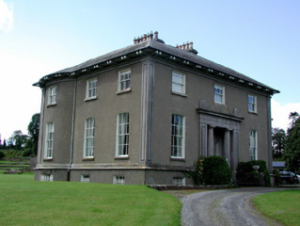
 The Skelligs, a pair of islands off the Dingle peninsula, Skellig Michael and Little Skellig, have UNESCO World Heritage Site status courtesy of their ornithological and archaeological significance. Little Skellig is the home of some 27,000 pairs of gannets, the second largest colony of such sea birds in the world.The monastic site on Skellig Micheal is reached by climbing over five hundred steps up a 1000 year-old stone stairway. Stone beehive huts where monks lived and prayed centuries ago cling to cliff edges alongside oratories, a cemetery, stone crosses, holy wells and the Church of St Michael. These isolated archaeological remains show the dramatically spartan conditions in which this early Christian community lived. Enduring several Viking raids, the monks eventually left the island in the thirteenth century and it subsequently became a place of pilgrimage. It is probably better known, however, for its being used as a location for two “Star Wars” films –The Force Awakens and The Last Jedi.
The Skelligs, a pair of islands off the Dingle peninsula, Skellig Michael and Little Skellig, have UNESCO World Heritage Site status courtesy of their ornithological and archaeological significance. Little Skellig is the home of some 27,000 pairs of gannets, the second largest colony of such sea birds in the world.The monastic site on Skellig Micheal is reached by climbing over five hundred steps up a 1000 year-old stone stairway. Stone beehive huts where monks lived and prayed centuries ago cling to cliff edges alongside oratories, a cemetery, stone crosses, holy wells and the Church of St Michael. These isolated archaeological remains show the dramatically spartan conditions in which this early Christian community lived. Enduring several Viking raids, the monks eventually left the island in the thirteenth century and it subsequently became a place of pilgrimage. It is probably better known, however, for its being used as a location for two “Star Wars” films –The Force Awakens and The Last Jedi. The Alexander family founded the Milford Flour Mills at Ballygowan, beside the River Barrow near Carlow town in 1790. By the 1830s the enterprise had reached a turnover of £195,000 a year. In 1856 disaster struck and the Mills were totally destroyed by fire. They had only recently been refurbished under the direction of William Fairbairn of Manchester. At the time of the fire they were capable of manufacturing from 45,000 to 50,000 sacks of flour per annum. It was thought that the fire occurred as a result of sparks, from the friction of grinding stones, igniting a quantity of corn. In 1891, the mill was modified to generate electricity and in so doing Carlow became the first inland town in Ireland or Britain to receive electric power. In the 1940s what remained of the malting building was converted into a tannery. Sheepskins from around Ireland were processed with the leather supplying shoe factories across the country. It also exported leather and chamois to the United Kingdom and the United States. Fire struck again in 1965 and the tannery closed down. In the 1990s the building was recommissioned and a concrete block turbine house added to generate electricity which feeds into the National Grid.
The Alexander family founded the Milford Flour Mills at Ballygowan, beside the River Barrow near Carlow town in 1790. By the 1830s the enterprise had reached a turnover of £195,000 a year. In 1856 disaster struck and the Mills were totally destroyed by fire. They had only recently been refurbished under the direction of William Fairbairn of Manchester. At the time of the fire they were capable of manufacturing from 45,000 to 50,000 sacks of flour per annum. It was thought that the fire occurred as a result of sparks, from the friction of grinding stones, igniting a quantity of corn. In 1891, the mill was modified to generate electricity and in so doing Carlow became the first inland town in Ireland or Britain to receive electric power. In the 1940s what remained of the malting building was converted into a tannery. Sheepskins from around Ireland were processed with the leather supplying shoe factories across the country. It also exported leather and chamois to the United Kingdom and the United States. Fire struck again in 1965 and the tannery closed down. In the 1990s the building was recommissioned and a concrete block turbine house added to generate electricity which feeds into the National Grid.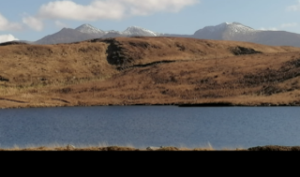 The McGillycuddy Reeks is one of Ireland’s most impressive mountain ranges. Their highest peaks can be seen here on a sunny March afternoon with a light covering of snow viewed across Lough Nakirka in Oulagh. The Climbers Inn is a hostelry favoured by walkers in the Reeks. It is also a recommended stop for cyclists, both pedal and motor varieties, as it is for those with four wheels who have enjoyed a spin over the agreeable mountain roads. You may have an opportunity to drop in here for a “quick one”.
The McGillycuddy Reeks is one of Ireland’s most impressive mountain ranges. Their highest peaks can be seen here on a sunny March afternoon with a light covering of snow viewed across Lough Nakirka in Oulagh. The Climbers Inn is a hostelry favoured by walkers in the Reeks. It is also a recommended stop for cyclists, both pedal and motor varieties, as it is for those with four wheels who have enjoyed a spin over the agreeable mountain roads. You may have an opportunity to drop in here for a “quick one”.
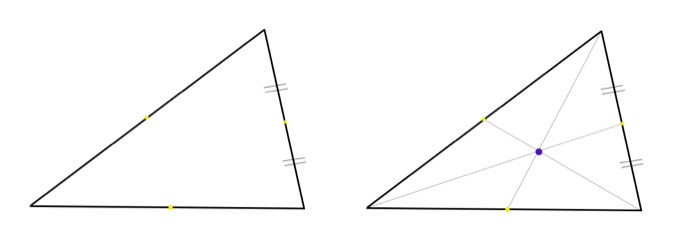 The centroid can be thought of as the centre of gravity of the triangle. Because our triangle is merely a shape on a page it is weightless and so can’t have a centre of gravity. Hence the term centroid.
The centroid can be thought of as the centre of gravity of the triangle. Because our triangle is merely a shape on a page it is weightless and so can’t have a centre of gravity. Hence the term centroid.